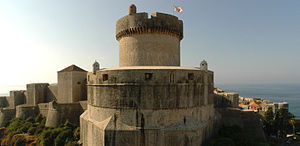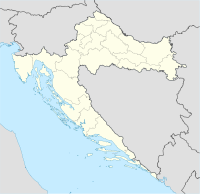The Walls of Dubrovnik (Croatian: Dubrovačke gradske zidine) are a series of defensive stone walls that have surrounded and protected the citizens of the afterward proclaimed maritime city-state of Dubrovnik (Ragusa), situated in southern Croatia, since the city's founding prior to the 7th century as a Byzantium castrum on a rocky island named Laus (Ragusia or Lave).[Note 1][1] With numerous additions and modifications throughout their history, they have been considered to be amongst the great fortification systems of the Middle Ages, as they were never breached by a hostile army during this time period.[2] In 1979, the old city of Dubrovnik, which includes a substantial portion of the old walls of Dubrovnik, joined the UNESCO list of World Heritage Sites.[3][4]
The oldest systems of fortifications around the town were likely wooden palisades.[5] Today's intact city walls, constructed mainly during the 12th–17th centuries,[6] mostly a double line, have long been a source of pride for Dubrovnik.[3] The walls run an uninterrupted course of approximately 1,940 metres (6,360 ft) in length, encircling most of the old city, and reach a maximum height of about 25 metres (82 ft).[3] The bulk of the existing walls and fortifications were constructed during the 14th and 15th centuries, but were continually extended and strengthened up until the 17th century.[5]
This complex structure, amongst the largest and most complete in Europe, protected the freedom and safety of a "civilised" and "sophisticated" republic that flourished in peace and prosperity for five centuries.[Note 2][7] The walls were reinforced by three circular and 14 quadrangular towers, five bastions (bulwarks), two angular fortifications and the large St. John's Fortress.[8] Land Walls were additionally reinforced by one larger bastion and nine smaller semicircular ones, like the casemate Fort Bokar, the oldest preserved fort of that kind in Europe.[8] The moat that ran around the outside section of the city walls which were armed by more than 120 cannons, made superb city defense.[9]
The construction of the first limestone forts around the city began in the Early Middle Ages, towards the end of the 8th century. But, the "old chronicles" say that some sort of castle reliably existed on the Lave peninsula quite a long time prior to that.[9] It is certain that the early town on Laus Island was also surrounded by defensive walls, probably mainly by wooden palisades.[5] The fact that Dubrovnik managed to survive a fifteen month-long invasion by the Saracens in the 9th century proves how well the city was fortified.[7][edit] Former city walls
The city first spread towards the uninhabited eastern part of the islet, which explains why the current name for the southeast part of the city, near St. John's Fortress, is called Pustijerna.[10] The name "Pustijerna" comes from the Latin statement "post terra", which means "outside the town".[10] In the 9th and 10th centuries, the defensive wall enclosed the eastern portion of the city.[10] When the sea channel separating the city from mainland was filled with earth in 11th century, the city merged with the settlement on land, and soon, a single wall was built around the area of the present-day city core.[10]
During this same time period, Dubrovnik and the surrounding area were described as a part of the Croatian (Grwasiah) entity, in one of the works by the famous Arab geographer Muhammad al-Idrisi.[11] In his book Nuzhat al-Mushataq fi ikhtiraq al-afaq (English: Joy for those who wish to sail over the world) from 1154, he mentioned Dubrovnik as the southernmost city of "the country of Croatia and Dalmatia".[11][12]
The basic city plan dates from 1292, when the port was rebuilt following a fire.[3] The whole city was entirely enclosed in the 13th century, except for the Dominican monastery, which came under its protection later on, during the 14th century.[13]
Modern-day city walls
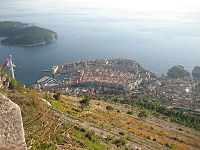
The present shape of the walls was defined in the 14th century.
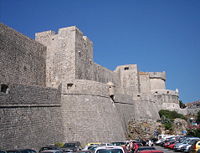
Land Walls protected with an additional range of slanted supporting walls, as defense against artillery fire.
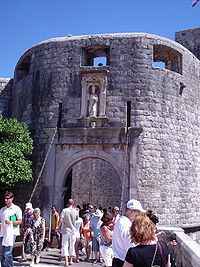
Fortified complex of the Pila Gates.
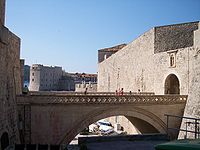
Gate of Ploča on the eastern side of the land walls, serve as the second major entrance to the city.
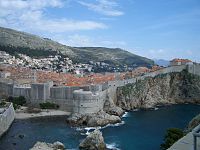
Sea Walls are much smaller than the land walls, due to additional protection by the high seaside cliffs.
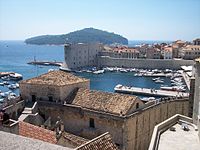
The City Harbour constructed by
Paskoje Miličević, got its present-day look in the 15th century.

View on Old town from Minčeta Tower, the city's most prominent point.
The city walls have been preserved to the present day, not only because of the knowledge of the skilled construction workers and the constant care provided by city dwellers that maintained and rebuilt the structures as needed, but also because of the brilliantly reputed diplomacy in Dubrovnik, which managed on many occasions to avoid dangerous measures taken by enemies against the Dubrovnik Republic.[10]
The present shape of the walls was defined in the 14th century after the city gained its full independence from Venetian suzerainty, but the peak of its construction lasted from the beginning of the 15th century until the latter half of the 16th century.[9] Being constructed very solidly, the walls were generally unaffected by a strong earthquake occurring in 1667.[9] The largest stimulus for continued development and emergency repairs and works of the Dubrovnik fortresses came as a result of the danger of unexpected attack by Turkish military forces, especially after they conquered Constantinople in 1453.[14] The city was also under latent danger of attack by the Venetians.[9] For centuries the people of Dubrovnik were able to preserve their city-republic by skillful maneuvering between East and West. A strategic treaty with Turkey protracted Dubrovnik’s liberty and maintained the opportunity for a major trading role between the Ottoman Empire and Europe.[3]
The irregular parallelogram surrounding Dubrovnik, consists of four strong fortresses at its most significant points.[10] To the north is the strong circular Minčeta Tower, and to the east side of the city port is the Revelin Fortress. The western city entrance is protected by the strong and nicely-shaped Fort Bokar, and the strong, freestanding, St. Lawrence Fortress (also known as Lovrijenac), protects the western side of the city from possible land and sea assaults. The large and complex St. John Fortress is located on the southeast side of the city.[10]
[edit] Land Walls
The main wall on the landside is 4 metres (13 ft) to 6 metres (20 ft) thick, and, at certain locations, the walls reach up to 25 meters (80 feet) in height.[14] The land walls stretch from Fort Bokar in the west to the detached Revelin Fortress in the east.[8] On the landside, the wall is protected with an additional range of slanted supporting walls as defense against artillery fire, especially against possible Ottoman attacks.[14][15]
The town has four city gates: two that lead to the harbor and two (with drawbridges) that lead to the mainland.[16] During the time period when the Austrian Empire controlled the city, two more gates were opened in the wall.[16]
Communication with the outside world on the landside was maintained with the city through two main well-protected city gates, one placed on the western side of the city and the other placed on the eastern side.[10] These entrances were constructed so that communications with the city could not be carried out directly; the messenger had to enter through multiple doors and walk down a winding passageway, which is evidence of the security measures taken as a last defense against the possibility of a surprise breach or entrance of unexpected visitors.[10]
[edit] Gate of Pila
The Pila Gates are a well-fortified complex with multiple doors, defended by Fort Bokar and the moat that ran around the outside section of the city walls.[10] At the entrance gate to the Old Town, on the western side of the land walls, there is a stone bridge between two Gothic arches, which were designed by the esteemed architect Paskoje Miličević in 1471.[17] That bridge connects to another bridge, a wooden drawbridge which can be pulled up.[17] During the republican era, the wooden drawbridge to the Pila Gate was hoisted each night with considerable pomp in a ceremony which delivered the city's keys to the Ragusan rector.[14] Today, it spans a dry moat whose garden offers respite from crowds.[14] Above the bridges, over the arch of town's principal gateway, there is a statue of city patron Saint Blaise (Croatian: Sveti Vlaho), with a model of the Renaissance city.[14] After passing the Pile Gate's original Gothic inner gateway, it is possible to reach one of a three access points to the city walls.[14]
[edit] Gate of Ploča
On the eastern side of the land walls, stands the second major entrance to the city, the Gate of Ploča. This gate is protected by the freestanding Revelin Fortress, which are connected by a wooden drawbridge and a twin-spanned stone bridge spanning a protective ditch.[10][13] The Outer Gate of Ploča was designed and constructed by architect Mihajlo Hranjac in 1628, while the two bridges to the Revelin Fortress were built in 15th century by Paskoje Miličević.[17] Miličević was also designed the Pila Gate bridges, which explains the similarities between the bridges.[17] Over the bridge, just like with the Gate of Pila, there is the statue of Saint Blaise, the patron saint of Dubrovnik.[17]
[edit] Gate of Buža
The Gate of Buža (meaning "hole") is located on the northern side of the land walls. This gate is relatively new compared to the other gates, as it was constructed during the early 1900s.[18]
[edit] Sea Walls
The main wall on the sea-facing side of Dubrovnik, stretches from Fort Bokar in the west to St. John Fortress in the south, and to the Revelin Frotress on the land-side.[8] These walls are 1.5 to 5 meters (5–16 feet) thick, depending on their location and its strategic importance.[8] The purpose of these walls were to help defend the city from sea-based attacks, particularly from the Republic of Venice, which was often considered a threat to Dubrovnik's safety.[15]
[edit] City Harbour
One of the oldest sectors of Dubovnik was constructed around a Late Antique castle by the sea, which stretched landwards a bit more than it does today.[19] It was constructed on the site of the Pre-Romanesque cathedral and the Rector's Palace, thus encircling the city's harbour.[19] The harbour was designed and constructed by engineer Paskoje Miličević in late 15th century.[19] Notably, the harbour was noticeably painted on the palm of St. Blaise in a triptych painted by the artist Nikola Božidarević around 1500.[19]
The most prominent portion of the harbour are the three enormous arches (the fourth original arch was walled in) of a large arsenal built in the late 12th century and enlarged in the latter part 15th century.[19] The harbour is also the oldest shipyard within the city and is still in use today.[19]
Porporela was built in 1873, next to St. John Fortress.[19] The Kase jetty (Kaše Breakwater) was built in 1485, according to the design of Paskoje Miličević, in order to defend the harbour and protect it from south-eastern winds and waves.[19] The breakwater thus shortened the harbour's bulky chain stretched in the night from the St. John Fortress to St. Luke's tower. It was constructed of huge stone blocks laid over wooden foundations without binder.[19]
Today, the arsenal hosts the City Café and a movie theatre, whereas both the harbour and Porporela have become pleasant promenades and tourist attractions.[19]
In the city port area, one of the most significant areas of the maritime trade city, there were two entrances: Gate of Ponte (port) and the Fishmarket Gate.[10] The entire layout of the Dubrovnik streets, as well as a range of expansions, was intended for fast and effective communication with the forts of the city walls.[10]
[edit] Gate of Ponte
Constructed in 1476, the Gate of Ponte is situated westwards from the Great Arsenal.[19] The city wall, built at the same period, leads from the Gate to St. John Fortress.[19] The present-day street of Damjan Juda, was formed in the 15th century when the sewage system was completed, and building houses against the western city wall was no longer allowed.[19]
[edit] The Fishmarket Gate
The Fishmarket Gate, built in 1381, stands eastward from the Great Arsenal. The three arches of the 15th century Small Arsenal, where small boats were repaired, are situated a bit further.[19] The old tower of St. Luke's protects the harbour in the east, and the harbour entrance is encircled and guarded by the Revelin Fortress.[19]
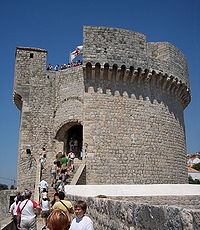
The Minčeta Tower is a symbol of the "unconquerable" city of
Dubrovnik.
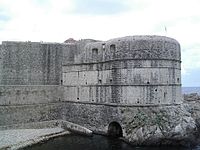
Fort Bokar is the key point in the defense of the Pila Gate.
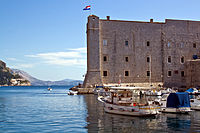
St. John
Fortress prevented enemy ships from accessing the City Harbour.
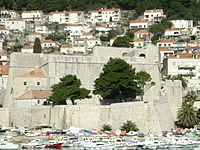
In 16th century Revelin
Fortress became the strongest city
fortress.
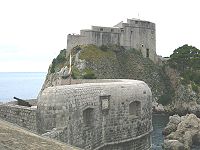
The walls of St. Lawrence
Fortress exposed to enemy fire are almost 12 metres (39 ft) thick.
[edit] Forts within walls
The fall of Constantinople in 1453 to the Ottomans was a clear sign to the cautious citizens of Dubrovnik that ample defensive measures were quickly needed, the strengthening of its defensive structures the foremost of the issues. The fall of Bosnia, which followed soon in 1463, only hastened the works. As a result, the Republic invited the architect Michelozzo di Bartolomeo of Florence to direct the improvement of the city's defenses. His work in Dubrovnik resulted in the construction and expansion of numerous buildings of key importance for the defense of Dubrovnik.[13]
[edit] Minčeta Tower
The Minčeta Tower was built by a local builder named Nicifor Ranjina and Italian engineers sent by Pope Pius II in 1463, at the height of the Turkish threat.[20] Originally as a strong four-sided fort,[13] it is the most prominent point in the defensive system towards the land. The tower's name derives from the name of the Menčetić family, who owned the ground upon which the tower was built.[13] By its height and impressive volume, the tower dominates the northwestern high part of the city and its walls.[13] In the middle of the 15th century, around the earlier quadrilateral fort, Michelozzo built a new round tower using new warfare technique and joined it to the new system of low scarp walls. The full six-meter (20 feet) thick walls of the new tower had a series of protected gun ports. The architect and sculptor Giorgio da Sebenico of Zadar, continued the work on the Minčeta tower. He designed and built the high narrow round tower, while the battlements are a later addition. The tower was completed in 1464, and became the symbol of the unconquerable city of Dubrovnik.[Note 3][13] Since it is the highest point of the wall, it is considered to offer a seemingly "unforgettable" view on the city.[13]
[edit] Fort Bokar
The Fort Bokar, often called "Zvjezdan", is considered to be amongst the most beautiful instances of harmonious and functional fortification architecture.[13] Built as a two-story casemate fortress by Michelozzo from 1461 to 1463, while the city walls were being reconstructed,[13] it stands in front of the medieval wall face protruding into space almost with its whole cylindrical volume.[13] It was conceived as the key point in the defense of the Pila Gate, the western fortified entrance of the city;[13] and after the Minčeta Tower, it is the second key point in the defense of the western land approach to the city.[13] It is said to be the oldest casemented fortress in Europe, which contains a small lapidary collection and numerous cannons.[17]
[edit] St. John Fortress
The St. John Fortress (Croatian: Sveti Ivan), often called Mulo Tower, is a complex monumental building on the southeastern side of the old city port, controlling and protecting its entrance. The first fort was built in mid 14th century, but it was modified on several occasions in the course of the 15th and 16th centuries, which can be seen in the triptych made by the painter Nikola Božidarević in the Dominican monastery.[13] The painting shows Saint Blaise, the patron saint of Dubrovnik.[13] Dominant in the port ambiance, the St. John Fortress prevented access of pirates and other enemy ships.[21] Always cautious at the first sign of danger, the inhabitants of Dubrovnik used to close the entry into the port with heavy chains stretched between the St. John Fortress and the Kase jetty, and they also used to wall up all the port entries to the Great Arsenal.[21]
Today, the fortress houses an aquarium on the ground floor, stocked with fishes from various parts of the Adriatic Sea. On the upper floors there is an ethnographic and a maritime museum devoted to the Republic Maritime Period, the Age of Steam, the Second World War, and the section of techniques of sailing and navigation.[17]
[edit] Detached forts
[edit] Revelin Fortress
In the period of unmistakable Turkish danger and the fall of Bosnia under Turkish rule, a detached fortress providing additional protection to the land approach to the eastern Ploče Gate was built to the east of the city in 1462.[13] The name Revelin derives from rivelino (ravelin), a term in military architecture which refers to work built opposite the city gate in order to afford better protection from enemy attack.[13] Danger of Venetian assault suddenly increased in the times of the First Holy League, and it was necessary to strengthen this vulnerable point of the city fortifications. The Senate hired Antonio Ferramolino, an experienced builder of fortresses in the service of the Spanish admiral Doria, a trusted friend of the Republic. In 1538 the Senate approved his drawings of the new, much stronger Revelin Fortress.[13] It took 11 years to build it, and during that time all other construction work in the city had stopped in order to finish this fortress as soon as possible.[13]
The new Revelin became the strongest of the city fortresses, safeguarding the eastern land approach to the city. Shaped in the form of an irregular quadrilateral with one of its sides descending towards the sea, it is protected by a deep ditch on the other. One bridge crosses the protective ditch and connects it to the Ploče Gate, while another bridge connects it to the eastern suburb. The construction work was executed so perfectly so that the devastating earthquake of 1667 did not damage Revelin.[13] Divided into 3 large vaulted rooms in its interior, Revelin became the administrative center of the Republic.[13]
[edit] St. Lawrence Fortress
St. Lawrence Fortress (Croatian: Lovrijenac), often called Dubrovnik's Gibraltar, is located outside the western city walls, 37 metres (121 ft) above sea level.[22] The fortress has a quadrilateral court with mighty arches and, as its height is uneven, it has 3 terraces with powerful parapets with the broadest one looking south towards the sea. Lovrijenac was defended with 10 large cannons, being the largest and most famous called "Lizard" (Croatian: Gušter). The walls exposed to enemy fire are almost 12 meters (39 feet) thick, but the large wall surface facing the city does not exceed 60 centimetres (2 feet).[13] Two drawbridges lead to the fort, there being the inscription "Non Bene Pro Toto Libertas Venditur Auro" – "Freedom is not to be sold for all the treasures in the world."[13] above the gate. To ensure loyalty, the troops in St. Lawrence Fortress were rotated every 30 days. And to ensure complete loyalty, they were given only 30 days of rations when they went in to the fort.[22] According to old scripts it was built in only three months.[17]
Today its interior is one of the most dignified stages in Europe, and a well-known place for William Shakespeare's Hamlet performances.[17]
[edit] Fortifications around Dubrovnik





